The Tramways of
Ciudad Juárez
BY
Allen Morrison
(Ciudad
Juárez was called Paso del Norte until 1888. The river which
separates it from El Paso, Texas, is called Río Bravo in Mexico
but Rio Grande in the USA.)
Mexico
had two international tramways which crossed the Río Bravo
between Mexico and the USA. Actually there were three lines, since the
circular route between Ciudad Juárez and El Paso crossed the
river twice. (The other international tramway was at Nuevo Laredo.)
Ciudad Juárez, in Chihuahua state, is 1,971 km from Mexico City
and the northern terminus of the Mexican Central Railway. Its
population was 30,000 in 1900 and is 1.2 million today.
In
December 1881 Felipe Arellano secured a franchise to build a streetcar
line and the following May acquired permission to run it to the USA.
Arellano formed the Compañía del Ferrocarril Urbano y
Puente de Paso del Norte (Paso del Norte Street Railway and Bridge
Company), purchased trams from the John Stephenson Co. in New York,
built a bridge at the end of Av. Lerdo and opened a mule-drawn tramway
to El Paso in 1882 [see map].
This was the world's first international streetcar line. The steam
railroad to Mexico City opened in 1884. Arellano built another tram
line on the Av. Juárez bridge in 1888 and renamed his company
Tranvías de Ciudad Juárez in 1898. Judging from the
architecture and the "DON'T PARK" sign, the photograph reproduced on the postcard below was taken in El Paso [col. AM]:
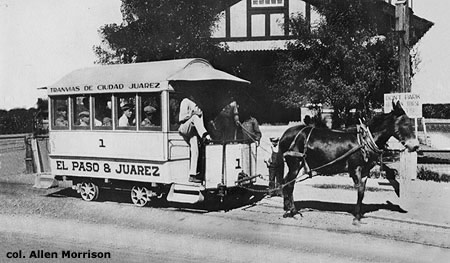
An
international streetcar line was a complex affair. Technically, there
were separate tramway operations in both countries which ended at the
border in the middle of the river. In practical terms, the tram systems
in both countries and the lines between them were operated by the
tramway company in El Paso, which acquired the Ciudad Juárez
operation in 1900. The new El Paso Electric Railway ordered eight
9-bench electric trams, #1-8, from American Car Co. in 1901 and built a
single clockwise loop line across both bridges: south on Stanton St.
over the river to Av. Lerdo in Ciudad Juárez, then north on Av.
Juárez onto El Paso St. back in El Paso [see map].
The new electric tramway - 5 km long and the fourth constructed in
Mexico - was inaugurated on 11 January 1902. The postcard view below
shows an open car going north on the Av. Juárez bridge, from
Ciudad Juárez toward El Paso (note the sagging wire). The
cameraman is facing east. [col. AM]:
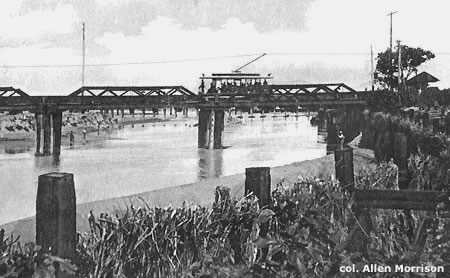
The
view below is south. Open car 2 has just crossed the Av. Juárez
bridge and is arriving in the USA. It is signed for the "RACE TRACK" in Ciudad Juárez, where it will go after a swing through downtown El Paso [see map]. The hipódromo in Ciudad Juárez, which opened in 1909, brought many gringos across the border [pc, col. AM]:
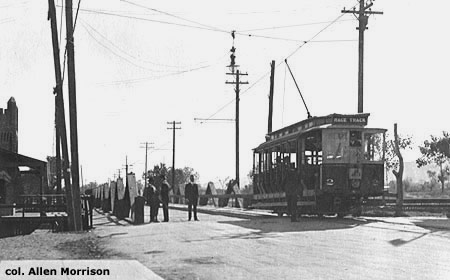
El Paso Electric Railway
purchased many more trams in succeeding years, including large 4-axle
models from St. Louis, Brill and American Car Co. Number 9 is one of
six 15-bench models, #9-14, supplied by Brill in 1903. They were
rebuilt as 12-window closed trams #79-84 in 1910 [col. Juan Viladrosa]:
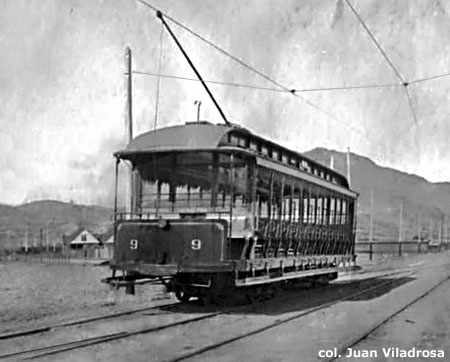
Meanwhile, number 72 below is from an unidentified group, or groups, whose numbers ended in 78 [col. Juan Viladroza]:
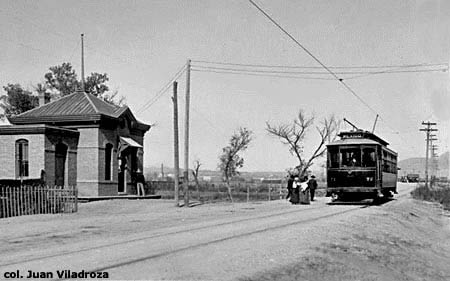
Tram 80, below, is one of the early Brill open cars that was rebuilt closed [see above]. On this postcard view it is traveling west on Av. 16 de Septiembre in Ciudad Juárez [see map]. The tracks of the Mexican Central Railway cross in the background. Note the MONTERREY BAR [col. AM]:
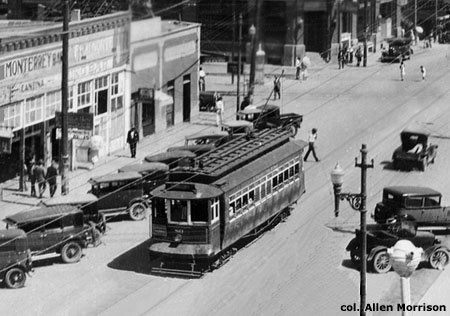
The postcard below, from the 1930s, shows tram 83 of the same type crossing the Stanton St./Av. Lerdo bridge [see map]. The view is north; that's El Paso and Franklin Mountain in the background [col. AM]:
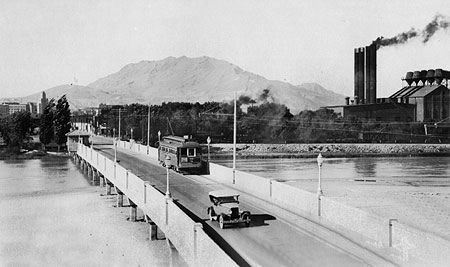
The
view below, from the 1940s, shows tram 88 at the same spot as 83 above,
traveling south on the Stanton St./Av. Lerdo bridge [see map].
Number 88 was one of six 8-wheel closed trams that El Paso Electric
Railway purchased from St. Louis Car Co. in 1912 [pc, col. AM]:
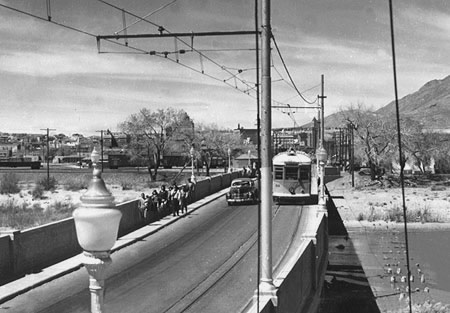
The RACE TRACK
line in Ciudad Juárez closed in 1945 and the remaining routes in
El Paso in 1947. Thereafter the tram system was reduced to the circular
international line across the bridges. The governments of both
countries liked the tramway because it facilitated border control. But
the vehicles were 40 years old. When the tramway system in San Diego,
California, closed in 1949 El Paso purchased its PCC cars and gave its
line a new life. The postcard below from the 1950s shows a PCC going
west on Av. 16 de Septiembre in Ciudad Juárez - at the same
corner as tram 80 in the fourth picture above. There is a new building
on the corner and the MONTERREY BAR is now called OCHOA. The railroad tracks are more evident here [col. AM]:
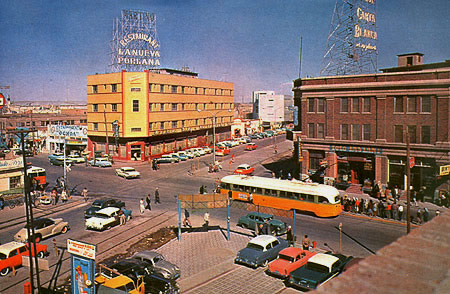
The
euphoria was short-lived. After 84 years of floods, strikes, border
disputes and raids by Pancho Villa (who liked to snip the trolley
wire), the international tramway closed completely in August 1966 so
that the bridges could be rebuilt. The line reopened in November 1967,
but closed again in July 1969 so that the Customs House could be
enlarged. It reopened again in November 1970, but closed again in
August 1971 so that streets could be widened. It reopened in October
1972, but closed again in July 1973 after a dispute with the toll
collectors. When tram 1516 ventured into Mexico on 31 July 1973 it was
confiscated by the Mexican government, which canceled the American
company's right to operate in Mexico. Tram service resumed along a
truncated route on the American side in November, but ended again on 4
May 1974. Car 1516 was returned to the U.S. in August, but despite
renewed efforts tram service was never restored. The vehicles remained
in the El Paso depot for several years, then were dispersed. In 1977
the mayor of Ciudad Juárez had the rails removed from his
streets.
BIBLIOGRAPHY (in order of publication)
Mexico, Secretaria de Comunicaciones y Obras Públicas. Reseña Histórica y Estadística de los Ferrocarriles de Jurisdicción Federal, 1905.
Mexico City, 1905. "Ferrocarril de Ciudad Juárez a la
Línea Divisoria y Puente Internacional", pp. 46-48, describes
franchises and early legal problems.
Tom P. Walker. "Folks May War; Cars Must Run" in AERA
(New York), August 1925, pp. 87-91. Lurid account, by El Paso Electric
Railway director, of the problems encountered on an international
streetcar line.
"El Paso - Juárez". Modern Tramway (London), December 1974, pp. 337-339. Report about the off again on again tram service.
Henry J. Leinbach, Jr. "El Paso Electric Company, Transportation Division: A Tentative History" in Southern Traction (San Antonio) no. 9, 10 December 1975. Good history of the company and description of its equipment.
Oscar J. Martínez. Border Boom Town: Ciudad Juárez Since 1848. Austin, 1978. The streetcar squabbles, pp. 124-125.
Edward A. Ridolph, Jr. "The International Trolley" in National Railway Historical Society Bulletin (Philadelphia), January 1991, pp. 22-27. Brief history and details, map and photographs of the last days.
There are many more pictures of trams in Ciudad Juárez linked on my webpage about Electric Transport in Latin America.
return to
INTRODUCTION & INDEX MAP
Copyright © 2003 Allen Morrison - ALL RIGHTS RESERVED
|








